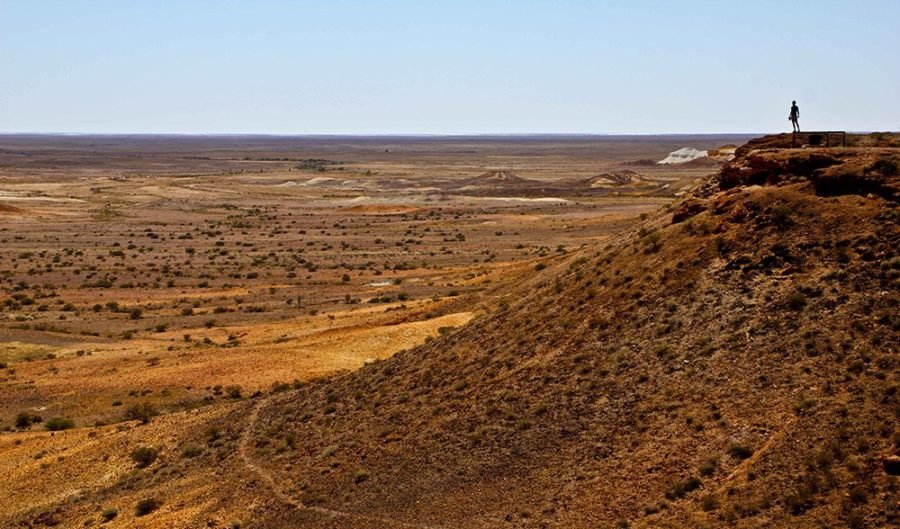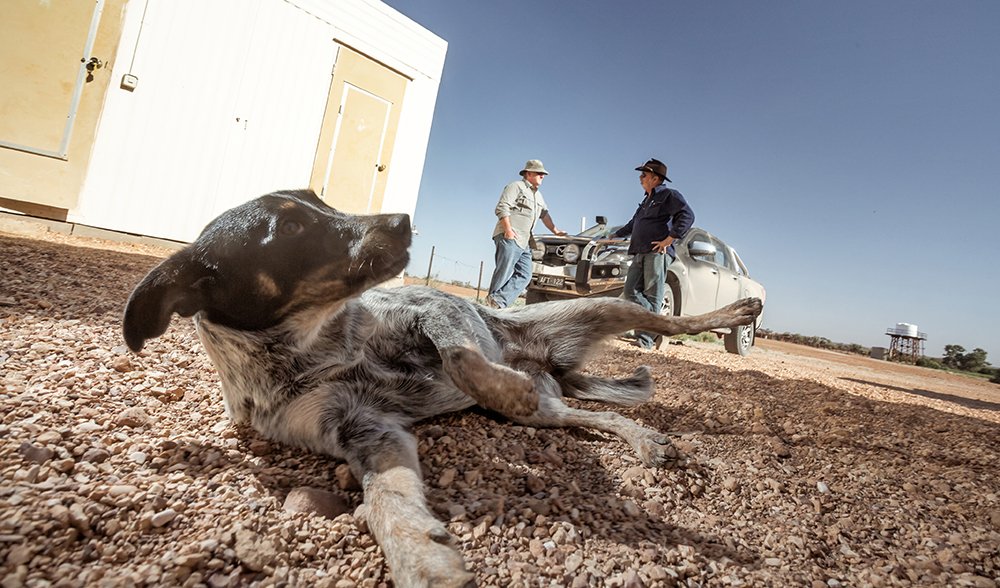Road trip: Coober Pedy, South Australia

Tales of grand outback adventure often fail to mention the flies. The flies and the heat. Yet they are your constant companions out in Australia’s red-hot heart. Out here, they are facts of life: you will be abuzz with flies (hundreds at all times, drinking the moisture from your skin, hair, corners of your mouth and around your eyes) and you will bake in the skin-searing, spirit-sapping dry heat.
But that’s part of the fun.
The outback and, further inland still, the desert, are welcome challenges. Endure them and you enjoy them.
The place of precious stones
When we flew into Coober Pedy, the surrounding landscape was an intriguing sight: seemingly barren, sparsely vegetated but peppered with dark, ominous holes. Those holes are the most obvious signs here of exploration for what have been at times this region’s lifeblood: opals.
Coober Pedy is a stunning oddity: a quirky mish-mash of Indigenous influence and migrant culture through the decades, sprinkled with the trappings of modern-day life, replete with fast food, satellite TV and brand-new dual-cab utes.

We landed on the small airstrip just outside of town, swiped at the first of many thousands of flies and marvelled at the intense heat. We threw our gear in an awaiting Mazda BT-50 dual-cab XTR, bush-ready with bullbar and snorkel, and set off.
The search for opals here, about 846km from Adelaide, has been going on for more than a century; the first opal claim was pegged in February 1915. Living conditions above ground are so harsh that many years ago, some people started building their homes below ground and residing there, where the temperature is reportedly a constant 21 degrees Celsius – so you really can’t blame them.
But we weren’t here to discover precious gemstones; we were here to tackle some of the toughest outback driving in Australia.
Our convoy, heading north for Oodnadatta, had only hit about 9km on the tripmeter when the bitumen ended and the fun – and gravel – started.
South Australia’s bewitching outback stretched away from us in all directions, beckoning.
The inland sea
It’s a mixed-up world out here, a captivating blend of gibber plains and sand hills; sometimes a moonscape; sometimes a stark blue sky over rocky outcrops. It hasn’t rained here in six years.
Our route led through cattle stations north of Coober Pedy, including the imposing Mt Barry Station, which begins about 100km north of the dusty town. We rumbled over cattle grids on our way.
Suffice to say, this is no country for city slickers. If you don’t have what it takes to survive, to thrive, out here, then you’re found out pretty quickly. Looks don’t count out here; ability does; reliability does.
Journeys between towns are adventures unto themselves, through washouts and over corrugations in a hard shower of scattered rocks. You could tackle these trips in a 2WD, sure, but a 4WD offers much more in the way of comfort and sure-footedness.
Our BT-50 had no problems.
Most of the major tracks we drove during this bush jaunt were in pretty good nick and the section we did of the 620km-long Oodnadatta Track, stretching between Marree and Marla, was no different. But venture off-road and it takes judicious driving to avoid punctures; there are sharper-than-nails rocks, as well as the short, strong shafts of broken, pointed sticks to contend with.
After 230km, we entered Oodnadatta, the “hottest and driest” town in Australia. We pulled into the legendary Pink Roadhouse – $2/litre for diesel – and tucked into some burgers.

Later, a perfectly cloudless blue sky framed a huge cloud of dust frozen mid-air, as we stood in the scorching midday sun, sipping water, while a police officer performed low-speed doughnuts around a dusty claypan in our BT-50.
The South Australian cop was doing gentle circle-work on part of the “6 x 4 trail” we were having fun on, just outside of Oodnadatta – and he was having a great time.
Only minutes before, we’d seen the police LandCruiser approaching our position from a kilometre away, gliding across a rich-red sandy track. We saw all of this because we were stuck. Door-sill deep in sand, atop a dune. Bogged.
Don’t get me wrong: the BT-50 can go almost anywhere. It took two experienced but easily distracted travellers to prevent it conquering this obstacle. We’d relied on speed to tackle a small but steep-ish dune and had come unstuck at a mound of deep sand just before the dune’s crest. Corrugations in the sand at the top – caused over time by drivers with over-inflated tyres doing just what we had done – had forced us into a terminal bounce, which had then drained all of our momentum. The more we tried to gun out of it, the deeper the wheels dug.
We deserved the strife: we’d been running our tyres at 30psi which, by my reckoning, was almost twice as much air as we should have had in them. And with temps tickling the upper 40s at that stage, our tyres would have been nudging 35psi or more.
The support crew swung into action, dropped our tyre pressures and snatch-strapped us out in no time.
We headed for our overnight accommodation at Arckaringa Station, about 90km south-west of Oodnadatta and 150km north of Coober Pedy, stopping at a lookout to marvel at the majestic wonder of the Painted Desert, an ancient inland sea bed so named because of the brightly coloured orange, yellow and white shale on the hills.
Standing there, soaking up the atmosphere, the Painted Desert looked unreal, like a massive painting perched in front of us, close enough to touch. Photographers and videographers in our party were working overtime, making the most of the stunning backdrop this amazing natural attraction provided.
After ditching our gear in our tents, we accepted an invitation from Arckaringa’s owner Paul to test out the BT-50s on an improvised 4WD course along twisting, sandy tracks, through dry river beds, and up and down washed out and rocky creek banks.
The BT-50s looked the goods and proved their mettle, but Paul still refused to commit when we asked him if he was going to ditch his Toyota for a Mazda.
A journey well worth making
That night, we slept under billions of stars at Arckaringa. The station covers 2745 square kilometres and is rated by the South Australian Pastoral Board to run up to 2100 head of cattle. It has on-site cabins and camping and it’s a bloody top joint.
The next morning, as we drove out of the station in convoy, a wedge-tailed eagle wheeled about in the sky high above us.
On the return trip to Coober Pedy, we pulled off to the side of the track to tackle a bit of serious rock crawling. We didn’t want the adventure to end. It was low-range fun on the steep climbs and Hill Descent Control heaven on the descents.
There’s a raw delight to driving in the outback. Nothing like it. The scenery is incredible and ever-changing, as is the terrain. The light is eye-scaldingly bright. During the day, the sky is crisp and clear blue; the night sky is a black blanket, peppered and aflame with bright, twinkling stars.
After more than 500km of outback adventure, every bloke in our touring crew had a Big Sky smile.
We’ve been out here loads of times but that doesn’t matter in the grand scheme of things because the landscape and light, the blue-sky brightness and the sun-bleached sand, the people and the places never fail to surprise, never fail to amaze.
Built for adventure
The modern-day dual-cab ute is the greatest all-rounder there is – and it just keeps getting better with every model released. Utes are now more refined, safer and more capable off-road than ever.
Mazda’s BT-50 has being winning over buyers and motoring journalists for years; the only thing anyone could agree on as a flaw in the previous model was its ‘smiley’ front end. Well, now that’s been replaced with a tough, chunky, squared-off presence, so the new BT-50 looks better, tougher, than its predecessor.
Off-road, this BT-50 went everywhere it wanted to – and it did it in comfort and with style. We drove it over heavily corrugated dirt tracks, flirted with gibber plain traverses and took on super-heated sand, all the while feeling neither rattled nor jolted nor otherwise out of sorts as you would in utes of not-so-old.
With 4-Low mode and electronic aids selected (Hill Descent Control included), this ute virtually drove itself over every off-road challenge we pointed it at. Choose the line, choose the gear and away you go.
The 3.2L five-cylinder engine – producing an outback-ready 147kW@3000rpm and 470Nm@1750-2500rpm – is nicely mated to the six-speed auto, producing plenty of real-world power and low-down grunt when it matters.
It’s no disappointment on gravel or bitumen, offering a car-like ride: stable, predictable and comfortable.
We drove along sandy creek-beds and up and down deeply rutted washouts. No problem. We drove it up a rocky hillside as high as we could until the severity of the slope screamed at us to stop.
So, the BT-50 proved itself on and off the road.
New optional gear includes a great Hema Maps package which you’d be crazy not to order.

